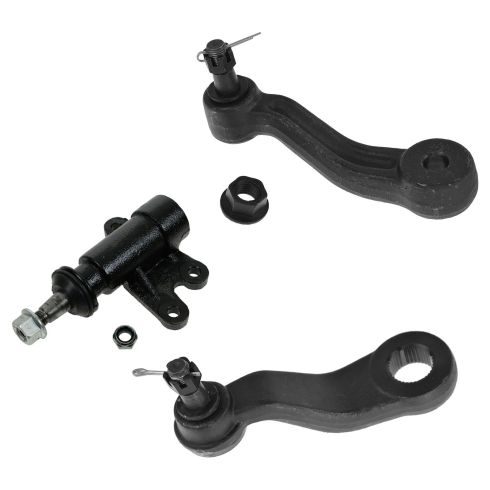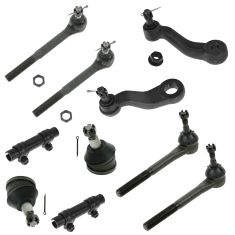1ASFK02087-Chevrolet GMC Cadillac Front Driver & Passenger Side 3 Piece Steering Kit TRQ PSA58488
Replaces
1997 GMC C1500 Truck Front Driver & Passenger Side 3 Piece Steering Kit TRQ PSA58488
Product Reviews
Loading reviews
4.56/ 5.0
16
16 reviews
November 7, 2017
They have accurate service and Speedy Delivery no hassle service great prices
front end steering parts
September 7, 2018
I ordered this front end steering replacement kit and I can tell you it is as good or better than the parts you get from your local auto parts supply stores. I will be using A1 Auto from now on for all my replacement part for my auto.
Back on the road
December 9, 2018
1aAuto is how you get back on the road. Worn out factory steering parts replaced with greaseless parts from 1aAuto and work great. Nice and solid steering with easy reference to videos for tool selection tricks to get it done
Perfect fit, easy installation
April 16, 2019
Perfect fit, easy installation thanks 1A auto,
steering kit- i was sent the wrong tie rods and now I have to re-do the repair
October 22, 2019
The total experience...The tie rod part was out of stock so I had to wait for it. Once it came, I jacked up my car and tore it down. I replaced the pitman arm, Idler arm and tie rods. I hired a mechanic to come to my house to help install the tie rods and pitman/idler arm, as I had heard that these can be tricky. He came over, and installed them. it cost me $250.00 for his time. I was now into the project $397.00. I took it to Les Scwab to have the alignment done to find out that I was sent the wrong tie rod ends and that they were 3 degrees off because the tie rods were too long and I would have to do the project over again. Les Scwab automotive charged me $60.00 for their time. $457.00 into the project and I have to do it again!
I am not real happy! For this price, I could of had someone elso do the work and purchase their parts from whomever. 1A did not come through for me.
works as it is suppose to
November 6, 2019
Glad I found this kit. works great so far. I would have
given it 5 stars except they were not serviceable. no grease zerks. shipping was fast. overall I would recommend to friend's and family. Thanks guy's.
November 23, 2019
Once again good quality parts great price.
The parts arrived in a timely manner, I damaged and fit perfectly. Very pleased overall, however, was expecting a grease fitting or serviceable part not a sealed unit.
August 20, 2020
Write your review here. It must be at least 4 characters long. Consider whether yThe parts arrived in a timely manner, I damaged and fit perfectly. Very pleased overall, however, was expecting a grease fitting or serviceable part not a sealed unit.ou would recommend this product and what you like or dislike about it.
Im a happy customer
May 22, 2021
These parts arrived quickly and fit perfectly. The A1 installation videos made the job much easier!
February 22, 2022
Factory fit.
Great
March 18, 2022
Great
Saved more when buying the whole kit.
March 23, 2023
The idler arm bracket was defective out of the box. My truck was already up on a ramp at the alignment shop when this was discovered so it really wasn't convenient to take the truck back and wait to replace the part. I had to buy a part from the shop and have them install it. However 1A Auto gave me a refund for the part and I didn't even have to wait to send it back. They earned my respect when it comes to customer service.
excellent
August 2, 2023
everything perfect exact stuff that I ordered
May 19, 2024
Very happy with the parts and quality
TRQ suspension part = top quality
August 8, 2024
Everything arrived at my house within 24 hours. Perfect fit and quality appears good
upon installation. No issues with install.
September 20, 2024
Good quality
Customer Q&A
Does the parts for part number 1ASFK02087 fit single cab or extended cab 1994 Chevy c1500 p/u?
May 30, 2016
10
These will fit all model 94 Chevy c1500. It is not specific to the cab size.
May 31, 2016
Derek C
10
I would think these would fit either size bed since they are front end parts. I have a 97 K2500 HD and ordered a similar set from 1A and they fit perfect.. The folks at 1A will exchange them if they don't fit.
May 31, 2016
Dave R
10
They will fit both, but setting the toe will be necessary. The "line up splines" (the four large ones ) are a bit off. I installed it properly with my steering wheel locked at 12 o'clock. When done however, I had to hold the wheel at 2 o'clock to go straight.
May 31, 2016
Robert H
10
My truck is a 1999 Tahoe 4 wheel drive. Not sure if it is compatible with a 1994. However, The idler fit fine, but the pitman arm only went on halfway. Could not use it. Sorry I was not of any help to you.
June 1, 2016
Greg V
10
Yes it should, we used it on our k1500 suburban 4x4. No problems installing - still trucking with our 1A Auto part.
June 1, 2016
Alice S
10
I have a 1995 single cab K1500 that this part fits. I don't know if the 2 w.d. versions have different systems.
June 1, 2016
Mike H
What's the difference in the steering components from a 1993 Chevrolet k1500 to a 1990 chevy k1500?
July 29, 2019
10
Thank you for your inquiry! While we could not tell you specifically what is different between those models, we can tell you that these parts specifically will be different.
July 30, 2019
T I
GMC is a registered trademark of General Motors Company. 1A Auto is not affiliated with or sponsored by GMC or General Motors Company.
See all trademarks.
































